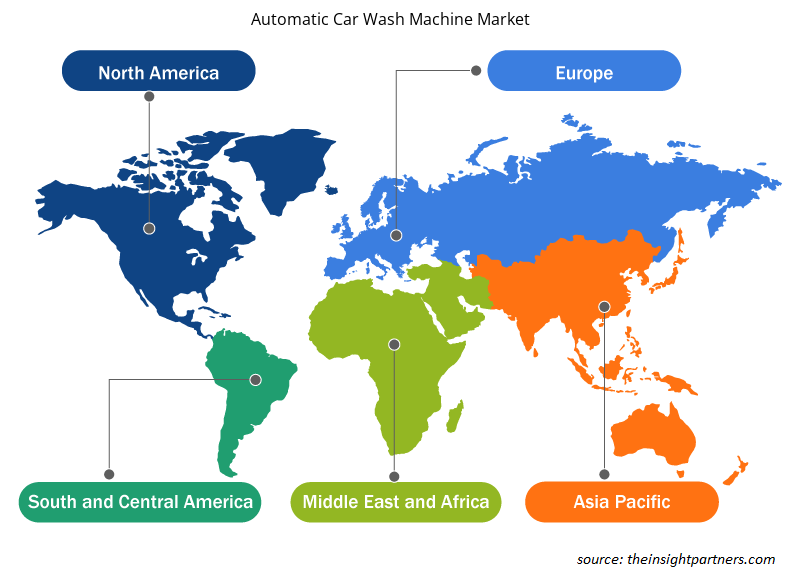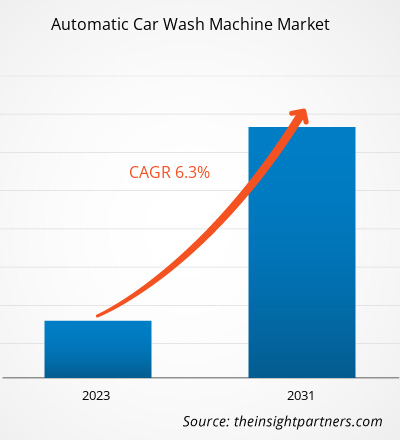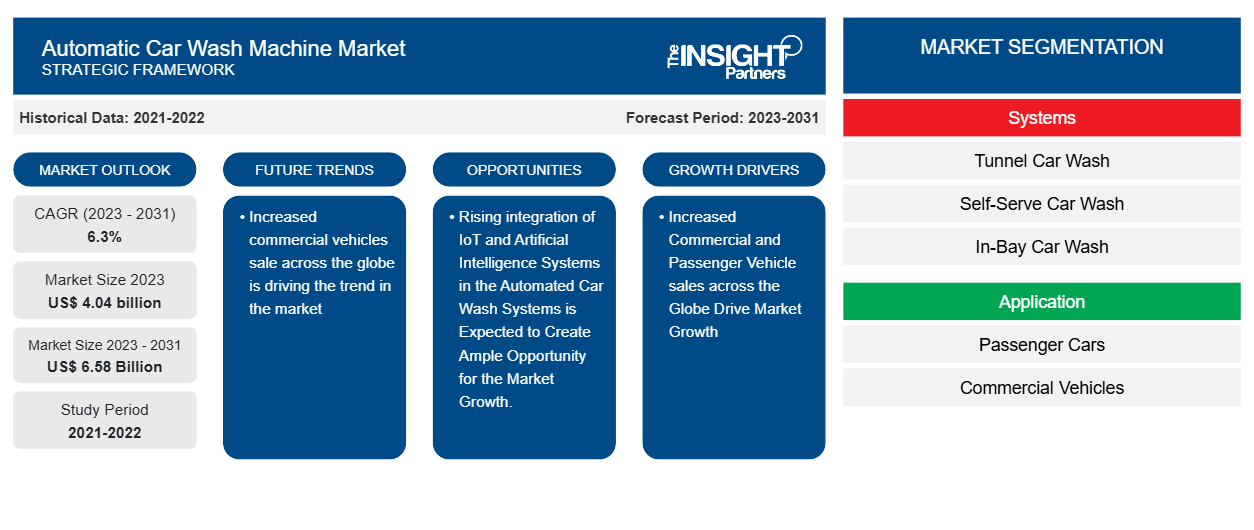Der Markt für automatische Autowaschanlagen soll von 4,04 Milliarden US-Dollar im Jahr 2023 auf 6,58 Milliarden US-Dollar im Jahr 2031 anwachsen. Der Markt soll in den Jahren 2023–2031 eine durchschnittliche jährliche Wachstumsrate (CAGR) von 6,3 % verzeichnen. Steigendes verfügbares Einkommen, wachsende Kaufkraft der Verbraucher in Entwicklungsländern sowie steigende Nutzfahrzeugverkäufe weltweit treiben den Markt für automatische Autowaschanlagen an. Laut der Internationalen Organisation der Kraftfahrzeughersteller stiegen die weltweiten Nutzfahrzeugverkäufe im Jahr 2023 auf 27,45 Millionen Einheiten, ein Anstieg von 24,22 Millionen Einheiten im Vergleich zum Jahr 2022. Nutzfahrzeuge nutzen automatische Autowaschanlagen, um ihre Fahrzeuge sauber und ordentlich zu halten.
Automatische Autowaschanlage Marktanalyse
Die Nachfrage nach automatischen Autowaschanlagen wird durch das gestiegene verfügbare Einkommen und den weltweiten Fahrzeugabsatz angetrieben. Nach Angaben der Internationalen Organisation der Kraftfahrzeughersteller (IOM) beliefen sich die weltweiten Fahrzeugverkäufe im Jahr 2023 auf 92,72 Millionen Einheiten, ein Anstieg von 82,87 Millionen Einheiten im Vergleich zum Jahr 2022. Ein solches Wachstum der Fahrzeugverkäufe dürfte dem Markt für automatische Autowaschanlagen reichlich Chancen bieten. Länder im asiatisch-pazifischen Raum wie China und Indien verzeichnen das schnellste Wachstum bei automatischen Autowaschanlagen aufgrund der steigenden Verkäufe von Personenkraftwagen und Nutzfahrzeugen in diesen Ländern. Der asiatisch-pazifische Raum ist die am schnellsten wachsende Region für das Wachstum des Marktes für automatische Autowaschanlagen. Indien ist das sechstgrößte Autoproduktionsland der Welt. Fahrzeuge sind in einer großen Anzahl von Marken und Modellen erhältlich. Die Fahrzeugwartung ist ein aufstrebendes Geschäft. Angesichts der größeren Nachfrage nach einer organisierten Autowäsche wird das Autoservicegeschäft nach der Kundenzufriedenheit bewertet. Das Aussehen und die Sauberkeit der Fahrzeuge spielen eine entscheidende Rolle bei der Erreichung dieser Zufriedenheit. Zeit und Arbeitskräfte sind nicht mehr so gefragt. Es ist keine leichte Aufgabe, ein Auto gründlich zu waschen. Das manuelle Waschen eines Autos ist sehr zeit- und arbeitsintensiv. Autobesitzer in der Stadt bevorzugen einen schnelleren Waschvorgang.
Marktübersicht für automatische Autowaschanlagen
Eine automatische Autowaschanlage ist ein automatisiertes Autowaschsystem, das aus mehreren Komponenten besteht, wie Motoren, Antrieben, Aktuatoren, Ventilen und Pumpen. Die Nachfrage nach automatischen Autowaschanlagen wird durch das steigende verfügbare Einkommen der Verbraucher, wachsende Autoverkäufe und eine erhöhte Kaufkraft der Verbraucher angetrieben. Laut der Weltbankorganisation beträgt das durchschnittliche verfügbare Haushaltseinkommen pro Kopf in den USA etwa 51.147 US-Dollar pro Jahr und wächst moderat. Dies hat eine enorme Nachfrage nach Wachstum auf dem Markt für automatische Autowaschanlagen geschaffen. Es gibt verschiedene Arten von automatischen Autowaschanlagen, wie z. B. Tunnelwaschanlagen, Selbstbedienungswaschanlagen und Autowaschanlagen in der Bucht. Unter diesen hat die Autowaschanlage in der Bucht im Jahr 2023 den größten Anteil. Dies ist in erster Linie auf die kostengünstigere und höhere Effizienz dieser Maschine im Vergleich zu anderen Maschinen zurückzuführen. Diese Art von Maschine kann Autos effizient ohne menschliches Eingreifen waschen.
Passen Sie diesen Bericht Ihren Anforderungen an
Sie erhalten kostenlos individuelle Anpassungen an jedem Bericht, einschließlich Teilen dieses Berichts oder einer Analyse auf Länderebene, eines Excel-Datenpakets sowie tolle Angebote und Rabatte für Start-ups und Universitäten.
-
Holen Sie sich die wichtigsten Markttrends aus diesem Bericht.Dieses KOSTENLOSE Beispiel umfasst eine Datenanalyse von Markttrends bis hin zu Schätzungen und Prognosen.
Markttreiber und Chancen für automatische Autowaschanlagen
Steigende Nutzfahrzeug- und Personenkraftwagenverkäufe weltweit treiben das Marktwachstum an
Automatische Autowaschanlagen werden häufig verwendet, um Fahrzeuge gründlich zu reinigen. Der steigende Absatz von Personen- und Nutzfahrzeugen weltweit ist der wichtigste Antriebsfaktor für das Wachstum des Marktes für automatische Autowaschanlagen. Laut der Internationalen Organisation der Kraftfahrzeughersteller (IOM) erreichten die weltweiten Automobilverkäufe 2023 92,72 Millionen, was einem Anstieg von 11,9 % gegenüber 2022 entspricht. Automatische Autowaschanlagen haben in den letzten Jahren aufgrund eines Anstiegs der Verbraucherausgaben und eines höheren verfügbaren Einkommens der Verbraucher ein deutliches Wachstum gezeigt. In den USA betrug das durchschnittliche verfügbare Haushaltseinkommen pro Kopf im Jahr 2023 rund 51.147 US-Dollar pro Jahr. Auch das durchschnittliche verfügbare Einkommen der Länder der Organisation für wirtschaftliche Zusammenarbeit und Entwicklung (OECD) erreichte durchschnittlich 30.490 US-Dollar pro Jahr. Das steigende verfügbare Einkommen der Menschen auf der ganzen Welt ist der wichtigste Antriebsfaktor für den Markt für automatische Autowaschanlagen. Mit dem steigenden verfügbaren Einkommen der Menschen werden die Verbraucher wahrscheinlich das zusätzliche Zubehör für die Autowäsche verwenden . Ein solches Wachstum der Automobilverkäufe und das gestiegene verfügbare Einkommen der Menschen treiben das Wachstum des Marktes für automatische Autowaschanlagen voran.
Die zunehmende Integration von IoT- und künstlichen Intelligenzsystemen in automatische Autowaschanlagen dürfte reichlich Chancen für das Marktwachstum schaffen.
Die Integration von KI und IoT in automatische Autowaschanlagen wächst rasant. Die führenden Hersteller bringen automatische Autowaschanlagen auf Basis fortschrittlicher Technologien auf den Markt und entwickeln diese weiter, um der wachsenden weltweiten Nachfrage nach Autowaschanlagen gerecht zu werden. Außerdem weiten die führenden Akteure ihre Aktivitäten aus, um automatische Autowaschlösungen und -dienste anzubieten. So verfügt beispielsweise Magnolia Wash Holdings, Teil von Whistle Express Car Wash, im Dezember 2023 über mehr als 100 Autowaschzentren in den USA. Das Unternehmen hat seine Aktivitäten im Südwesten und Mittleren Westen der USA ausgeweitet. Darüber hinaus brachte Zhejiang YGL Intelligent Technology Co., LTD. im August 2021 eine intelligente Autowaschanlage mit integrierter KI auf den Markt und präsentierte sie im Hangzhou International Expo Center in China.
Automatische Autowaschmaschine Marktbericht Segmentierungsanalyse
Wichtige Segmente, die zur Ableitung der Marktanalyse für automatische Autowaschmaschinen beigetragen haben, sind Typ, Plattform, Anwendung und Endbenutzer.
- Basierend auf den Systemen ist der Markt in Tunnelwaschanlagen, Selbstbedienungswaschanlagen und Autowaschanlagen in der Bucht unterteilt. Unter diesen hat die Autowaschanlage in der Bucht den größten Anteil, da diese Maschinen im Vergleich zu anderen kostengünstiger und effizienter sind.
- Basierend auf der Anwendung wird der Markt in Pkw und Nutzfahrzeuge unterteilt. Darunter haben Pkw den größten Anteil, da das verfügbare Einkommen der Verbraucher steigt und die Pkw-Verkäufe weltweit steigen.
Automatische Autowaschanlage Marktanteilsanalyse nach Geografie
Der geografische Umfang des Marktberichts für automatische Autowaschmaschinen ist hauptsächlich in fünf Regionen unterteilt: Nordamerika, Europa, Asien-Pazifik, Naher Osten und Afrika sowie Südamerika.
Nordamerika hat den Markt für automatische Autowaschanlagen im Jahr 2023 dominiert. Laut der Internationalen Organisation der Kraftfahrzeughersteller (OICA) erreichte die Nutzfahrzeugproduktion in Nordamerika im Jahr 2022 rund 10,4 Millionen und stieg von 9,7 Millionen im Vorjahr 2021. Laut der oben genannten Organisation erreichte die Pkw-Produktion in Nordamerika im Jahr 2022 2,69 Millionen Einheiten, was einem Anstieg von 5,5 % gegenüber 2021 entspricht. Nordamerika umfasst mehrere führende Automobilmarkenhersteller, darunter General Motors Co., Ford Motor Co., PACCAR Inc., Tesla Inc., Navistar International Corp, Rivian Automotive Inc. und BMW AG. Diese Premium-Fahrzeugmarkenbesitzer verwenden automatisierte Autowaschsysteme.
Diese Untersuchung bezog sich auf verschiedene Datenquellen wie die Organisation Internationale Organisation der Kraftfahrzeughersteller, Transmission Rebuilders Network Worldwide, Automatic Transmission Rebuilders Association (ATRA), Automotive Service Association (ASA), Automotive Aftermarket Association Southeast (AAAS) und verschiedene Automobilorganisationen in verschiedenen Ländern.
Regionale Einblicke in den Markt für automatische Autowaschanlagen
Die regionalen Trends und Faktoren, die den Markt für automatische Autowaschanlagen im Prognosezeitraum beeinflussen, wurden von den Analysten von Insight Partners ausführlich erläutert. In diesem Abschnitt werden auch die Marktsegmente und die Geografie für automatische Autowaschanlagen in Nordamerika, Europa, im asiatisch-pazifischen Raum, im Nahen Osten und Afrika sowie in Süd- und Mittelamerika erörtert.

- Erhalten Sie regionalspezifische Daten zum Markt für automatische Autowaschanlagen
Umfang des Marktberichts über automatische Autowaschmaschinen
| Berichtsattribut | Details |
|---|---|
| Marktgröße im Jahr 2023 | 4,04 Milliarden US-Dollar |
| Marktgröße bis 2031 | 6,58 Milliarden US-Dollar |
| Globale CAGR (2023 - 2031) | 6,3 % |
| Historische Daten | 2021-2022 |
| Prognosezeitraum | 2023–2031 |
| Abgedeckte Segmente |
Nach Systemen
|
| Abgedeckte Regionen und Länder |
Nordamerika
|
| Marktführer und wichtige Unternehmensprofile |
|
Dichte der Marktteilnehmer für automatische Autowaschanlagen: Die Auswirkungen auf die Geschäftsdynamik verstehen
Der Markt für automatische Autowaschanlagen wächst rasant, angetrieben durch die steigende Nachfrage der Endnutzer aufgrund von Faktoren wie sich entwickelnden Verbraucherpräferenzen, technologischen Fortschritten und einem größeren Bewusstsein für die Vorteile des Produkts. Mit steigender Nachfrage erweitern Unternehmen ihr Angebot, entwickeln Innovationen, um die Bedürfnisse der Verbraucher zu erfüllen, und nutzen neue Trends, was das Marktwachstum weiter ankurbelt.
Die Marktteilnehmerdichte bezieht sich auf die Verteilung von Firmen oder Unternehmen, die in einem bestimmten Markt oder einer bestimmten Branche tätig sind. Sie gibt an, wie viele Wettbewerber (Marktteilnehmer) in einem bestimmten Marktraum im Verhältnis zu seiner Größe oder seinem gesamten Marktwert präsent sind.
Die wichtigsten auf dem Markt für automatische Autowaschanlagen tätigen Unternehmen sind:
- Autec, Inc.
- Coleman Hanna
- Carolina Pride Autowaschsysteme und -lösungen
- MacNeil Wash Systems, Autowaschanlagen in Motor City
- NS Waschsysteme
- PECO Autowaschanlagen
Haftungsausschluss : Die oben aufgeführten Unternehmen sind nicht in einer bestimmten Reihenfolge aufgeführt.

- Überblick über die wichtigsten Akteure auf dem Markt für automatische Autowaschanlagen
Marktnachrichten und aktuelle Entwicklungen für automatische Autowaschanlagen
Der Markt für automatische Autowaschanlagen wird durch die Erhebung qualitativer und quantitativer Daten nach Primär- und Sekundärforschung bewertet, die wichtige Unternehmensveröffentlichungen, Verbandsdaten und Datenbanken umfasst. Im Folgenden finden Sie eine Liste der Entwicklungen auf dem Markt für automatische Autowaschanlagen und Strategien:
- Im April 2023 brachte ISTOBAL die nächste Generation der automatischen Portalwaschanlagen M'WASH auf den Markt. Die Portalwaschanlage ist effizient und mit vernetzten Technologien ausgestattet, um die Rentabilität des Fahrzeugreinigungsgeschäfts zu steigern. Zu den auf den Markt gebrachten Modellen gehören M'WASH4 und M'WASH3 PRO, Portalwaschanlagen, die mit produktiveren, zuverlässigeren und sichereren Technologien ein umfassendes Angebot für alle Anforderungen an Autowaschsysteme bieten. (Quelle: Flyability, Pressemitteilung/Unternehmenswebsite/Newsletter)
Marktbericht zu automatischen Autowaschanlagen – Abdeckung und Ergebnisse
Der Bericht „Marktgröße und Prognose für automatische Autowaschmaschinen (2021–2031)“ bietet eine detaillierte Analyse des Marktes, die die folgenden Bereiche abdeckt:
- Marktgröße und Prognose auf globaler, regionaler und Länderebene für alle wichtigen Marktsegmente, die im Rahmen des Projekts abgedeckt sind
- Marktdynamik wie Treiber, Beschränkungen und wichtige Chancen
- Wichtige Zukunftstrends
- Detaillierte Porter's Five Forces Analyse
- Globale und regionale Marktanalyse mit wichtigen Markttrends, wichtigen Akteuren, Vorschriften und aktuellen Marktentwicklungen
- Branchenlandschaft und Wettbewerbsanalyse, einschließlich Marktkonzentration, Heatmap-Analyse, prominenten Akteuren und aktuellen Entwicklungen
- Detaillierte Firmenprofile mit SWOT-Analyse
- Historische Analyse (2 Jahre), Basisjahr, Prognose (7 Jahre) mit CAGR
- PEST- und SWOT-Analyse
- Marktgröße Wert/Volumen – Global, Regional, Land
- Branchen- und Wettbewerbslandschaft
- Excel-Datensatz
Aktuelle Berichte
Verwandte Berichte
Erfahrungsberichte
Grund zum Kauf
- Fundierte Entscheidungsfindung
- Marktdynamik verstehen
- Wettbewerbsanalyse
- Kundeneinblicke
- Marktprognosen
- Risikominimierung
- Strategische Planung
- Investitionsbegründung
- Identifizierung neuer Märkte
- Verbesserung von Marketingstrategien
- Steigerung der Betriebseffizienz
- Anpassung an regulatorische Trends























 Kostenlose Probe anfordern für - Markt für automatische Autowaschanlagen
Kostenlose Probe anfordern für - Markt für automatische Autowaschanlagen